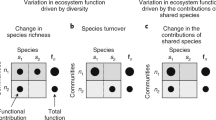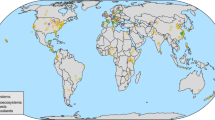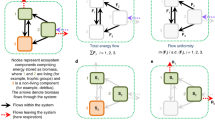Abstract
Ecosystem functioning depends on biodiversity at multiple trophic levels, yet relationships between multitrophic diversity and ecosystem multifunctionality have been poorly explored, with studies often focusing on individual trophic levels and functions and on specific ecosystem types. Here, we show that plant diversity can affect ecosystem functioning both directly and by affecting other trophic levels. Using data on 13 trophic groups and 13 ecosystem functions from two large biodiversity experiments—one representing temperate grasslands and the other subtropical forests—we found that plant diversity increases multifunctionality through elevated multitrophic diversity. Across both experiments, the association between multitrophic diversity and multifunctionality was stronger than the relationship between the diversity of individual trophic groups and multifunctionality. Our results also suggest that the role of multitrophic diversity is greater in forests than in grasslands. These findings imply that, to promote sustained ecosystem multifunctionality, conservation planning must consider the diversity of both plants and higher trophic levels.
This is a preview of subscription content, access via your institution
Access options
Access Nature and 54 other Nature Portfolio journals
Get Nature+, our best-value online-access subscription
$29.99 / 30 days
cancel any time
Subscribe to this journal
Receive 12 digital issues and online access to articles
$119.00 per year
only $9.92 per issue
Buy this article
- Purchase on SpringerLink
- Instant access to full article PDF
Prices may be subject to local taxes which are calculated during checkout




Similar content being viewed by others
Data availability
Biodiversity and ecosystem function data that support the findings of this study are available via Figshare at https://figshare.com/s/91cbc9f9aec78e2dced5 (ref. 81).
References
Ritchie, H. & Roser, M. Land use. Our World in Data https://ourworldindata.org/land-use (2019).
Anthony, M. A., Bender, S. F. & van der Heijden, M. G. A. Enumerating soil biodiversity. Proc. Natl Acad. Sci. USA 120, e2304663120 (2023).
Sachs, J. D., Kroll, C., Lafortune, G., Fuller, G. & Woelm, F. Sustainable Development Report 2022 (Cambridge Univ. Press, 2022).
Jaureguiberry, P. et al. The direct drivers of recent global anthropogenic biodiversity loss. Sci. Adv. 8, eabm9982 (2022).
Bongaarts, J. The Global Assessment Report on Biodiversity and Ecosystem Services: Summary for Policymakers (IPBES, 2019).
Fijen, T. P. et al. Insect pollination is at least as important for marketable crop yield as plant quality in a seed crop. Ecol. Lett. 21, 1704–1713 (2018).
Dainese, M. et al. A global synthesis reveals biodiversity-mediated benefits for crop production. Sci. Adv. 5, eaax0121 (2019).
Eisenhauer, N. et al. Ecosystem consequences of invertebrate decline. Curr. Biol. 33, 4538–4547 (2023).
Wang, S. & Brose, U. Biodiversity and ecosystem functioning in food webs: the vertical diversity hypothesis. Ecol. Lett. 21, 9–20 (2018).
Poisot, T., Mouquet, N. & Gravel, D. Trophic complementarity drives the biodiversity–ecosystem functioning relationship in food webs. Ecol. Lett. 16, 853–861 (2013).
Albert, G., Gauzens, B., Loreau, M., Wang, S. & Brose, U. The hidden role of multi‐trophic interactions in driving diversity–productivity relationships. Ecol. Lett. 25, 405–415 (2022).
Thébault, E. & Loreau, M. Food-web constraints on biodiversity–ecosystem functioning relationships. Proc. Natl Acad. Sci. USA 100, 14949–14954 (2003).
de Mazancourt, C., Loreau, M. & Abbadie, L. Grazing optimization and nutrient cycling: when do herbivores enhance plant production? Ecology 79, 2242–2252 (1998).
Symstad, A. J. & Tilman, D. Diversity loss, recruitment limitation, and ecosystem functioning: lessons learned from a removal experiment. Oikos 92, 424–435 (2001).
Allan, E. et al. A comparison of the strength of biodiversity effects across multiple functions. Oecologia 173, 223–237 (2013).
Duffy, J. E. Biodiversity loss, trophic skew and ecosystem functioning. Ecol. Lett. 6, 680–687 (2003).
Naeem, S. & Li, S. Biodiversity enhances ecosystem reliability. Nature 390, 507–509 (1997).
Mulder, C. P. H., Huss-Danell, K., Högberg, P. & Joshi, J. Insects affect relationships between plant species richness and ecosystem processes. Ecol. Lett. 2, 237–246 (1999).
Brose, U. & Hillebrand, H. Biodiversity and ecosystem functioning in dynamic landscapes. Phil. Trans. R. Soc. B 371, 20150267 (2016).
Balvanera, P. et al. Quantifying the evidence for biodiversity effects on ecosystem functioning and services. Ecol. Lett. 9, 1146–1156 (2006).
Huang, Y. et al. Impacts of species richness on productivity in a large-scale subtropical forest experiment. Science 362, 80–83 (2018).
Schuldt, A. et al. Biodiversity across trophic levels drives multifunctionality in highly diverse forests. Nat. Commun. 9, 2989 (2018).
Hautier, Y. et al. Local loss and spatial homogenization of plant diversity reduce ecosystem multifunctionality. Nat. Ecol. Evol. 2, 50–56 (2018).
Soliveres, S. et al. Biodiversity at multiple trophic levels is needed for ecosystem multifunctionality. Nature 536, 456–459 (2016).
Seibold, S. et al. Arthropod decline in grasslands and forests is associated with landscape-level drivers. Nature 574, 671–674 (2019).
Tilman, D., Lehman, C. L. & Thomson, K. T. Plant diversity and ecosystem productivity: theoretical considerations. Proc. Natl Acad. Sci. USA 94, 1857–1861 (1997).
Laforest-Lapointe, I., Paquette, A., Messier, C. & Kembel, S. W. Leaf bacterial diversity mediates plant diversity and ecosystem function relationships. Nature 546, 145–147 (2017).
Li, Y. et al. Multitrophic arthropod diversity mediates tree diversity effects on primary productivity. Nat. Ecol. Evol. 7, 832–840 (2023).
Buzhdygan, O. Y. et al. Biodiversity increases multitrophic energy use efficiency, flow and storage in grasslands. Nat. Ecol. Evol. 4, 393–405 (2020).
Meyer, S. T. et al. Biodiversity–multifunctionality relationships depend on identity and number of measured functions. Nat. Ecol. Evol. 2, 44–49 (2018).
Weisser, W. W. et al. Biodiversity effects on ecosystem functioning in a 15-year grassland experiment: patterns, mechanisms, and open questions. Basic Appl. Ecol. 23, 1–73 (2017).
Bruelheide, H. et al. Designing forest biodiversity experiments: general considerations illustrated by a new large experiment in subtropical China. Methods Ecol. Evol. 5, 74–89 (2014).
Maestre, F. T. et al. Plant species richness and ecosystem multifunctionality in global drylands. Science 335, 214–218 (2012).
Schuldt, A. et al. Multiple plant diversity components drive consumer communities across ecosystems. Nat. Commun. 10, 1460 (2019).
Scherber, C. et al. Bottom-up effects of plant diversity on multitrophic interactions in a biodiversity experiment. Nature 468, 553–556 (2010).
McQueen, D. J., Post, J. R. & Mills, E. L. Trophic relationships in freshwater pelagic ecosystems. Can. J. Fish. Aquat. Sci. 43, 1571–1581 (1986).
Delgado-Baquerizo, M. et al. Multiple elements of soil biodiversity drive ecosystem functions across biomes. Nat. Ecol. Evol. 4, 210–220 (2020).
Eisenhauer, N. et al. in Mechanisms Underlying the Relationship Between Biodiversity and Ecosystem Function. Advances in Ecological Research Vol. 61, (eds Eisenhauer, N, Bohan, D. A. & Dumbrell A. J.) 1–54 (2019).
Marquard, E. et al. Positive biodiversity–productivity relationship due to increased plant density. J. Ecol. 97, 696–704 (2009).
Lambers, J. H. R., Harpole, W. S., Tilman, D., Knops, J. & Reich, P. B. Mechanisms responsible for the positive diversity–productivity relationship in Minnesota grasslands. Ecol. Lett. 7, 661–668 (2004).
Schnabel, F. et al. Species richness stabilizes productivity via asynchrony and drought-tolerance diversity in a large-scale tree biodiversity experiment. Sci. Adv. 7, eabk1643 (2021).
Wagg, C. et al. Biodiversity–stability relationships strengthen over time in a long-term grassland experiment. Nat. Commun. 13, 7752 (2022).
Tilman, D., Reich, P. B. & Knops, J. M. Biodiversity and ecosystem stability in a decade-long grassland experiment. Nature 441, 629–632 (2006).
Lange, M. et al. Plant diversity increases soil microbial activity and soil carbon storage. Nat. Commun. 6, 6707 (2015).
Bezemer, T. M. et al. Soil community composition drives aboveground plant–herbivore–parasitoid interactions. Ecol. Lett. 8, 652–661 (2005).
Ristok, C. et al. Plant species richness elicits changes in the metabolome of grassland species via soil biotic legacy. J. Ecol. 107, 2240–2254 (2019).
Staab, M. et al. Dear neighbor: trees with extrafloral nectaries facilitate defense and growth of adjacent undefended trees. Ecology 104, e4057 (2023).
Lefcheck, J. S. et al. Biodiversity enhances ecosystem multifunctionality across trophic levels and habitats. Nat. Commun. 6, 1–7 (2015).
Stanton, N. The underground in grasslands. Annu. Rev. Ecol. Syst. 19, 573–589 (2003).
Vidal, M. C. & Murphy, S. M. Bottom-up vs. top-down effects on terrestrial insect herbivores: a meta-analysis. Ecol. Lett. 21, 138–150 (2018).
Duffy, J. E. et al. The functional role of biodiversity in ecosystems: incorporating trophic complexity. Ecol. Lett. 10, 522–538 (2007).
McGrady-Steed, J., Harris, P. M. & Morin, P. J. Biodiversity regulates ecosystem predictability. Nature 390, 162–165 (1997).
Naeem, S., Thompson, L. J., Lawler, S. P., Lawton, J. H. & Woodfin, R. M. Declining biodiversity can alter the performance of ecosystems. Nature 368, 734–737 (1994).
Schmid, B. in Defining Agroecology (eds Dormann, C. F. et al.) 161–174 (tredition.com, 2023).
Bruno, J. F. & O’Connor, M. I. Cascading effects of predator diversity and omnivory in a marine food web. Ecol. Lett. 8, 1048–1056 (2005).
Byrnes, J. et al. Predator diversity strengthens trophic cascades in kelp forests by modifying herbivore behaviour. Ecol. Lett. 9, 61–71 (2006).
Schuldt, A. et al. Carbon–biodiversity relationships in a highly diverse subtropical forest. Glob. Change Biol. 29, 5321–5333 (2023).
Roscher, C. et al. The role of biodiversity for element cycling and trophic interactions: an experimental approach in a grassland community. Basic Appl. Ecol. 5, 107–121 (2004).
Ebeling, A. et al. Plant diversity effects on arthropods and arthropod-dependent ecosystem functions in a biodiversity experiment. Basic Appl. Ecol. 26, 50–63 (2018).
Rzanny, M. & Voigt, W. Complexity of multitrophic interactions in a grassland ecosystem depends on plant species diversity. J. Anim. Ecol. 81, 614–627 (2012).
Cesarz, S. et al. Plant species richness sustains higher trophic levels of soil nematode communities after consecutive environmental perturbations. Oecologia 184, 715–728 (2017).
Eisenhauer, N. et al. Plant diversity effects on soil microorganisms support the singular hypothesis. Ecology 91, 485–496 (2010).
Wahdan, S. F. M. et al. Organic agricultural practice enhances arbuscular mycorrhizal symbiosis in correspondence to soil warming and altered precipitation patterns. Environ. Microbiol. 23, 6163–6176 (2021).
Chen, J.-T. et al. Functional and phylogenetic relationships link predators to plant diversity via trophic and non-trophic pathways. P. Roy. Soc. B-Biol. Sci. 290, 20221658 (2023).
Guo, P.-F. et al. Tree diversity promotes predatory wasps and parasitoids but not pollinator bees in a subtropical experimental forest. Basic Appl. Ecol. 53, 134–142 (2021).
Li, Y. et al. Tree diversity and functional leaf traits drive herbivore-associated microbiomes in subtropical China. Ecol. Evol. 11, 6153–6166 (2021).
Skarbek, C. J. et al. A tale of scale: plot but not neighbourhood tree diversity increases leaf litter ant diversity. J. Anim. Ecol. 89, 299–308 (2020).
Gan, H. et al. Plants play stronger effects on soil fungal than bacterial communities and co-occurrence network structures in a subtropical tree diversity experiment. Microbiol. Spectr. 10, e00134–00122 (2022).
Zhang, N. et al. Tree species richness and fungi in freshly fallen leaf litter: unique patterns of fungal species composition and their implications for enzymatic decomposition. Soil Biol. Biochem. 127, 120–126 (2018).
Meyer, S. T. et al. Effects of biodiversity strengthen over time as ecosystem functioning declines at low and increases at high biodiversity. Ecosphere 7, e01619 (2016).
Steinbeiss, S. et al. Plant diversity positively affects short-term soil carbon storage in experimental grasslands. Glob. Change Biol. 14, 2937–2949 (2008).
Bongers, F. J. et al. Functional diversity effects on productivity increase with age in a forest biodiversity experiment. Nat. Ecol. Evol. 5, 1594–1603 (2021).
Huang, Y. et al. Positive effects of tree species diversity on litterfall quantity and quality along a secondary successional chronosequence in a subtropical forest. J. Plant Ecol. 10, 28–35 (2017).
Schuldt, A., Fornoff, F., Bruelheide, H., Klein, A.-M. & Staab, M. Tree species richness attenuates the positive relationship between mutualistic ant–hemipteran interactions and leaf chewer herbivory. P. Roy. Soc. B-Biol. Sci. 284, 20171489 (2017).
Rutten, G. et al. More diverse tree communities promote foliar fungal pathogen diversity, but decrease infestation rates per tree species, in a subtropical biodiversity experiment. J. Ecol. 109, 2068–2080 (2021).
Allan, E. et al. Interannual variation in land-use intensity enhances grassland multidiversity. Proc. Natl Acad. Sci. USA 111, 308–313 (2014).
Byrnes, J. E. et al. Investigating the relationship between biodiversity and ecosystem multifunctionality: challenges and solutions. Methods Ecol. Evol. 5, 111–124 (2014).
Mori, A. S. et al. Low multifunctional redundancy of soil fungal diversity at multiple scales. Ecol. Lett. 19, 249–259 (2016).
Finlayson, M. et al. Ecosystems and Human Well-Being: Wetlands and Water. Synthesis (Millennium Ecosystem Assessment, 2005).
Lefcheck, J. S. piecewiseSEM: piecewise structural equation modelling in R for ecology, evolution, and systematics. Methods Ecol. Evol. 7, 573–579 (2016).
Li, Y. & Liu, X. Li et al_plot_level_multidiversity_multitrophicdiversity_data. Figshare https://figshare.com/s/91cbc9f9aec78e2dced5 (2024).
Acknowledgements
We thank the Jena Experiment consortium and the BEF-China platform for their efforts in maintaining the experiments and the many student helpers and local helpers for taking the measurements. This study was supported by the National Key Research Development Program of China (2022YFF0802300), the National Natural Science Foundation of China (32222055, 32301337 and 32161123003), the research units BEF-China and MultiTroph funded by the German Research Foundation (DFG FOR 891 and 452861007/FOR 5281, respectively), and the DFG-funded international research training group (TreeDí, 319936945/GRK2324). The Jena Experiment was supported by the DFG (FOR 5000). X.L. was funded by the Youth Innovation Promotion Association CAS (2023019). N.E. gratefully acknowledges the support of iDiv, which is funded by the DFG (FZT 118, 202548816 and Ei 862/29-1). A.M.K. was partly funded by a Hedda Anderson Visiting Chair grant.
Author information
Authors and Affiliations
Contributions
X.L. and K.M. contributed to the conceptualization of the project. Yi Li, A.S., A.E., N.E., Y.H., G.A., C.A., A.A., M. Bonkowski, H.B., M. Bröcher, D.C., J.C., Y.C., J-T.C., M.C., X.D., F.F., G.G., L.G., P.-F.G., A.H., A.K., M.L., S.L., Q.L., Yingbin Li, A.L., S.M., G.O., G.R., T.S., M.D.S., M.S., M.-Q.W., N.Z. and C.-D.Z. contributed to the methodology and investigation. Yi Li and X.L. contributed to the visualization. The writing was led by Yi Li, X.L., A.S., A.E., N.E., B.S., K.M. and D.C., with reviewing and editing contributed to by all authors.
Corresponding author
Ethics declarations
Competing interests
The authors declare no competing interests.
Peer review
Peer review information
Nature Ecology & Evolution thanks Lin Jiang and the other, anonymous, reviewer(s) for their contribution to the peer review of this work.
Additional information
Publisher’s note Springer Nature remains neutral with regard to jurisdictional claims in published maps and institutional affiliations.
Supplementary information
Supplementary Information
Supplementary Figs 1–9, and legends, Tables 1–6 and references.
Rights and permissions
Springer Nature or its licensor (e.g., a society or other partner) holds exclusive rights to this article under a publishing agreement with the author(s) or other rightsholder(s); author self-archiving of the accepted manuscript version of this article is solely governed by the terms of such publishing agreement and applicable law.
About this article
Cite this article
Li, Y., Schuldt, A., Ebeling, A. et al. Plant diversity enhances ecosystem multifunctionality via multitrophic diversity. Nat Ecol Evol (2024). https://doi.org/10.1038/s41559-024-02517-2
Received:
Accepted:
Published:
DOI: https://doi.org/10.1038/s41559-024-02517-2



